![]()
![]()
![]()
Use LEFT and RIGHT arrow keys to navigate between flashcards;
Use UP and DOWN arrow keys to flip the card;
H to show hint;
A reads text to speech;
31 Cards in this Set
- Front
- Back
- 3rd side (hint)
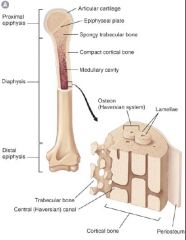
A.The upper panel depicts the structure of a long bone (exemplified by the humerus).
what does the daiphysis of the long bone consist of? What does the epiphysis and what does it surround, and what is the trabecular bone in the long bone? |

"Note that the diaphysis consists of a thick outer layer or cortex of compact cortical bone surrounding the bone marrow. • In the epiphysis, the cortex is thinner and surrounds trabecular bone as well as bone marrow; trabecular bone is also found in the vertebral bodies and much of the pelvis." |
|
|
|
bone remodeling is a dynamic balance between what two things? |
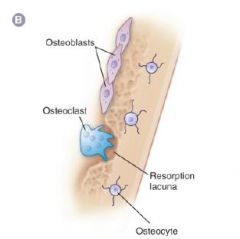
"The lower panel shows the detailed structure of bone. •Bone remodeling is a dynamic balance between the catabolic activity of osteoclasts and the anabolic activity of osteoblasts." |
|
|
|
1. To explain and describe the role of cells in bone remodelling and homeostasis. |
. |
. |
|
|
where are osteoblasts and osteoclasts found? |
•Osteoblasts and osteoclasts are found on all inner bone surfaces, including the endosteumthat lines cortical bone and the many surfaces in trabecular bone. Osteoblasts and osteoclasts are found on all inner bone surfaces, including the endosteum that lines cortical bone and the many surfaces in trabecular bone. |
|
|
|
bone remodeling is most intense in which bone? |
Bone remodeling is most intense in trabecular bone. |
|
|
|
consequently, conditions that disrupt bone remodeling and/or bone mineralization affect which bone preferentially? base treble |
Consequently, conditions that disrupt bone remodeling and/or bone mineralization affect trabecular bone preferentially (For example, osteoporotic fractures occur most commonly in vertebral bodies, which are predominantly trabecular bone.) |
base treble |
|
|
2.To explain and describe the role of PTH in plasma Ca2+ regulation. |
. |
. |
|
|
what are the fluxes of calcium net uptake per day from GI tract and exretion day by day by kidneys? love shoes |
In a state of whole-body calcium balance, the fluxes of calcium include net uptake of 200 mg per day from the GI tract and excretion of 200 mg per day by the kidneys |
katie holmes daughter loves shoes |
|
|
what enhances absorption of Ca2+ from GI tract? physical milk |
Calcitriol [1,25(OH)2D3] enhances absorption of Ca2+ from the GI tract. |
drink your physical milk for a good dose of calcitriol |
|
|
what does continuous secretion of PTH do? |
Continuous secretion of parathyroid hormone (PTH) increases bone formation and (even more) bone resorption, and stimulates renal tubular reabsorption of calcium; both effects raise plasma Ca2+, and also enhances renal clearance of inorganic phosphate (PO4). |
|
|
|
in contrast what does once daily injection of PTH do? |
In contrast, once-daily injection of PTH (in blue) stimulates new bone formation (accretion) more than it stimulates bone resorptionand has only transient (and consequently minor) effects on renal clearance of Ca2+and PO4. |
|
|
|
what does exogenous calcitonin do? boiling rice with oil |
Exogenous calcitonin (CT; also in blue) inhibits bone resorption. |
like boiling rice with oil, blocks reabsorption |
|
|
Bone resorptionand bone formation are coupled by the interactions between...
|
osteoblasts and osteoclasts: |
|
|
|
what does RANKL do? |
(2) RANKL binds to RANK, a receptor expressed on osteoclast precursors. |
|
|
|
(3) The RANKL–RANK binding interaction, together with macrophage colony-stimulating factor (M-CSF), causes what?
|
osteoclast precursors to differentiate into mature osteoclasts. |
|
|
|
(4) As mature osteoclasts resorb bone, matrix-bound factors such as TGF-β, insulin-like growth factor 1 (IGF-1), other growth factors, and cytokines are what?
|
released. |
|
|
|
3.To explain and describe the role of vitamin D and its analogues in bone pathophysiology.
|
. |
. |
|
|
what happens to endogenous and exogenous vitamin D in the liver and kidneys? |
Both endogenous and exogenous vitamin D are converted to 25-hydroxy vitamin D in the liver
and then to calcitriolin the kidney. |
|
|
|
how is calcitriolis sythesised. how is it catalyzed? |
Calcitriolis the active metabolite of vitamin D. Endogenous vitamin D3 is synthesized in the skin from 7-dehydrocholesterol, in a reaction that is catalyzed by ultraviolet light (UV-B). |
|
|
|
Exogenous vitamin D can be provided as what?
|
D3 (from animal sources) or as D2(from plant sources); D3and D2have the same biological activity.
|
|
|
|
Parathyroid hormone (PTH) does what in the kidney, what is the result of this?
|
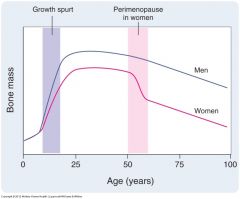
increases the activity of 1α-hydroxylase in the kidney and thereby stimulates the conversion of 25-hydroxy vitamin D to calcitriol, as does hypophosphatemia. |
Parathyroid hormone (PTH) increases the activity of 1α-hydroxylase in the kidney and thereby stimulates the conversion of 25-hydroxy vitamin D to calcitriol, as does hypophosphatemia.
|
|
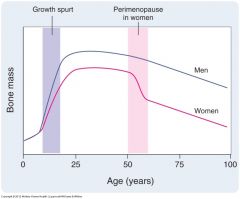
what happens after the peak? |
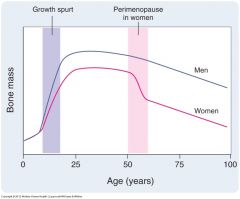
After the peak, bone mass gradually declines by approximately 0.7% per year. |
|
|
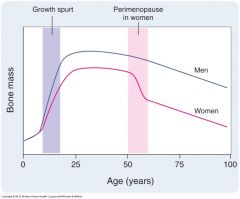
In women, the reduction in the frequency of menses coincides with
|
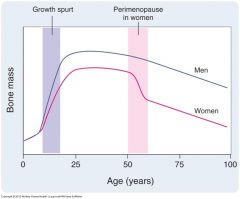
a sharp decline in bone mass, as the decrease in estrogen production leads to increased bone resorption. |
|
|
|
As bone mass decreases with age, the skeleton may become |
sufficiently fragile that minor trauma can cause fractures |
|
|
|
The goal of antiresorptive agents is to? what about goal of bone anabolic agents?
|
The goal of antiresorptive agents is to arrest or slow the loss of bone. In contrast, bone anabolic agents can be used to reverse bone loss that has already occurred and restore bone mass and bone structure. |
|
|
|
Although raloxifeneis not a steroid molecule, it is conformationally similar to..
|
17β-estradiol. |
|
|
|
Raloxifene binds towhat? what does this allow it to do?
|
the ligand binding domain on the estrogen receptor, allowing it to act as a partial estrogen agonist in some tissues (bone) and as an estrogen antagonist in other tissues (endometrium and breast). |
|
|
|
why does this selective action of raloxifene occur? |
This selective action occurs because the raloxifene–estrogen receptor complex can recruit either transcriptional coactivator or corepressor factors in a tissue-specific manner. |
|
|

what can you see about the structure comparison |

Note that the P-O-P structure of pyrophosphate is replaced with a P-C-P structure in bisphosphonate. |
|
|
|
This motif is conserved across the marketed bisphosphonates, whose R1and R2side chains differ: side chains containing a nitrogen atom have what?
|
higher potency. |
|
|
|
Substituting a hydroxyl for a hydrogen at R1 enhances what?
|
skeletal retention. |
|

